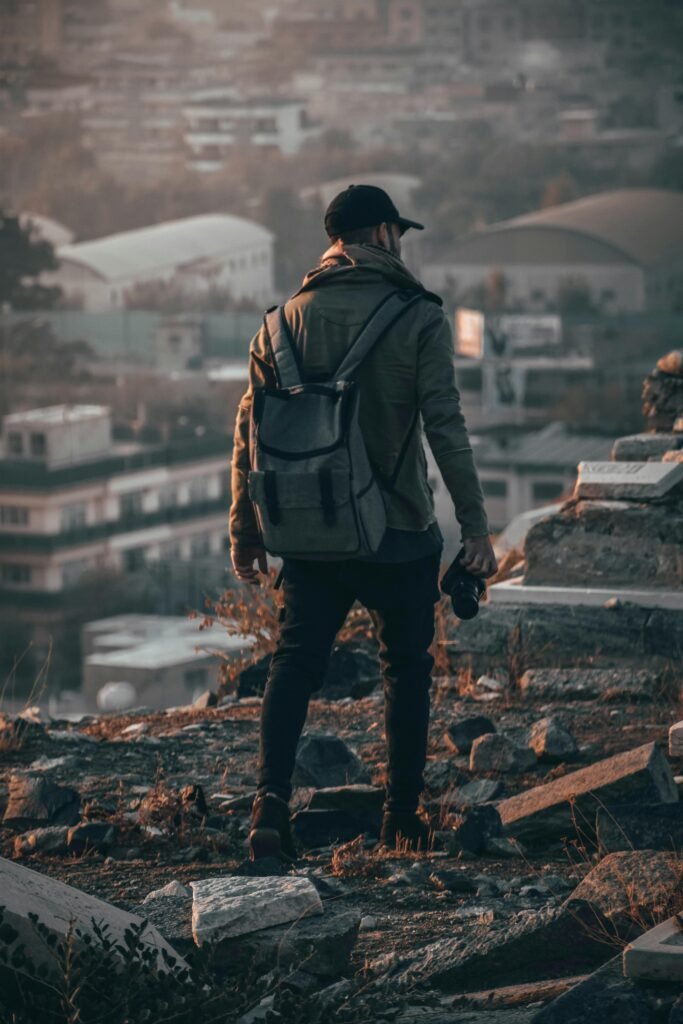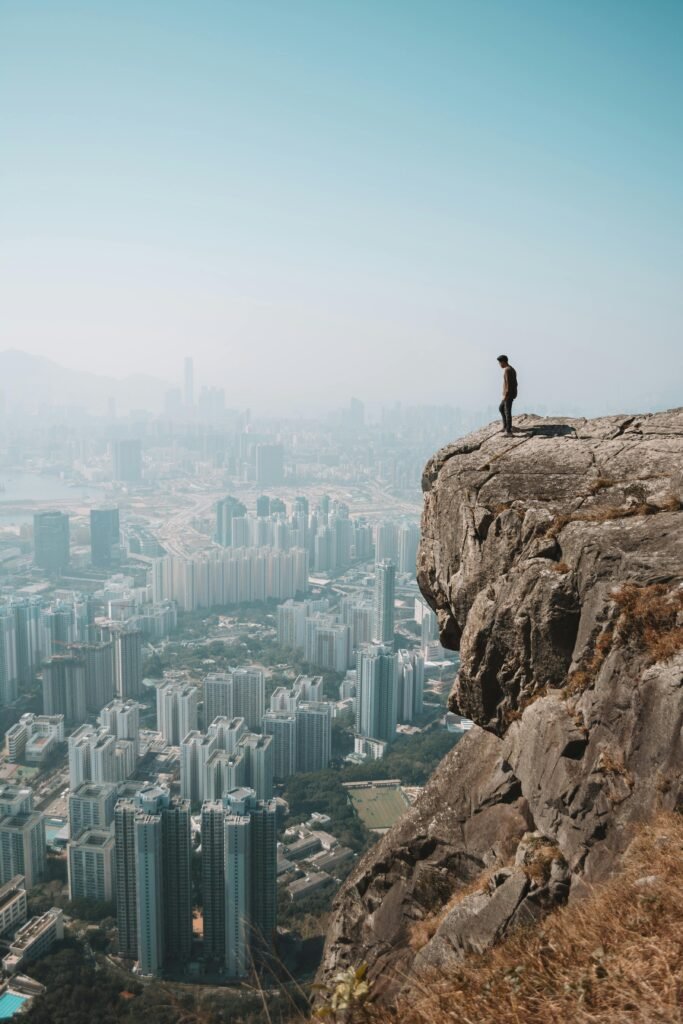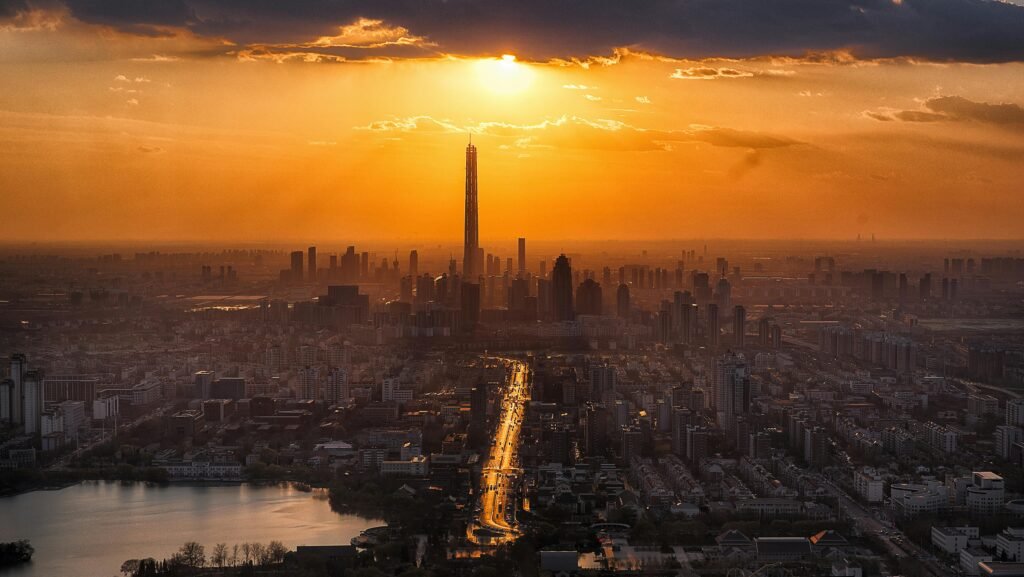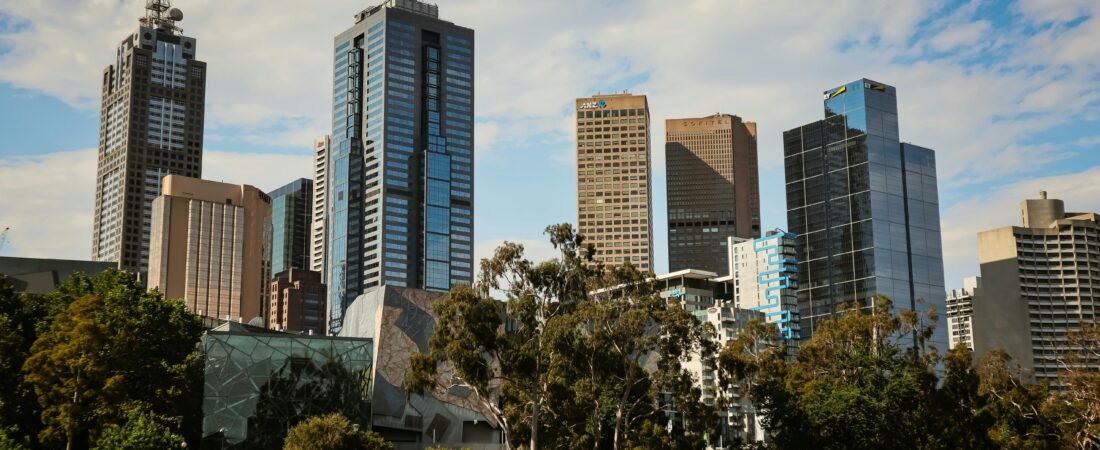Last updated: September 2025
You know that feeling when you’re scrolling through Instagram, seeing all those epic mountain trail photos, and thinking “I wish I lived somewhere more hikeable”?
Plot twist: you probably do. You just haven’t discovered urban hiking yet.
I spent years driving hours to reach “real” trails before I realized some of my best hiking experiences were happening right in my own city. That 8-mile loop through Seattle’s neighbourhoods that takes you up secret staircases to killer viewpoints? That’s a hike. The Brooklyn Bridge to DUMBO walk that leaves your legs burning and your camera roll full? Also a hike.
Urban hiking isn’t just walking around the city (though there’s nothing wrong with that). It’s about turning your urban environment into intentional trail networks, complete with elevation gain, scenic overlooks, and that satisfying tired-but-accomplished feeling you get after a good day on the trail.
Table of Contents
*This post may contain affiliate links. If you use them, I may earn a small commission at no extra cost to you.
What Actually Counts as Urban Hiking?
Cambdridge dictionary defines hiking as:
“The activity of going for long walks in the countryside”
– Cambdridge dictionary
Here’s the thing – if you’re walking with purpose through varied terrain for fitness, exploration, or both, you’re hiking. Doesn’t matter if that terrain is granite slabs or concrete steps.
Urban hiking uses city infrastructure as your trail system: sidewalks become your path, staircases provide elevation, parks offer natural sections, and those random pedestrian bridges become scenic overlooks.
The sweet spot is finding routes that combine multiple elements – maybe you start in a historic district, climb some epic public staircases, cut through a few parks, and end at a waterfront. Boom. That’s a legit hiking experience that happens to be in a city.
Why urban hiking works so well:
- Zero drive time to the trailhead (because there isn’t one)
- Built-in amenities like bathrooms, water fountains, and coffee shops
- Weather protection options along the way
- Public transit connections for point-to-point routes
- Safe, well-lit paths for evening adventures
Planning Routes That Actually Feel Like Adventures
The difference between a boring city walk and an epic urban hike comes down to route planning. You want variety, some challenge, and interesting stuff to see along the way.

Start with a Theme
Instead of randomly wandering, pick a focus:
Architecture buffs: String together different eras – Victorian neighborhoods to Art Deco downtown to modern waterfront developments. Chicago’s incredible for this.
Art hunters: Connect murals, galleries, and sculpture installations. Detroit’s Eastern Market to Midtown route is spectacular for street art.
Staircase seekers: Cities built on hills hide amazing public staircases. San Francisco has 600+ sets of public steps. Pittsburgh has 712 (!). These aren’t just functional – they’re often beautiful and always a workout.
History trackers: Follow old trade routes, former railway lines, or immigration paths through neighborhoods. Boston’s Freedom Trail is the famous example, but every city has stories written in its street patterns.
Green corridor cruisers: Link parks, greenways, and waterfronts. The High Line to Brooklyn Bridge Park via multiple neighborhoods gives you 12+ miles of mostly green space in NYC.
Distance and Difficulty Sweet Spots
Beginner-friendly: 3-5 miles with minimal elevation Intermediate: 5-8 miles with some hills or stair climbing
Advanced: 8-12+ miles with significant elevation or technical urban terrain.
Check 👉Hiking Effort Score Calculator for reference.
Pro tip: City miles feel different than trail miles. Concrete is harder on joints, but you also get more frequent rest opportunities. Start with that in mind.
Essential Route Planning Tools
- Google My Maps remains unbeaten for custom route creation. Drop pins at must-see spots, then connect them logically.
- AllTrails now includes urban routes in major cities – filter for “city walks” or “urban trails.”
- Strava Global Heatmap shows you where locals actually walk/run. Those bright orange lines? That’s where the good routes are.
Local apps worth downloading:
- Komoot: Excellent for door-to-door urban route planning
- MapQuest Walk: Underrated for finding pedestrian-only paths
- Citymapper: Best for integrating public transit into longer routes
Safety: City Hiking Common Sense
Urban hiking safety is mostly common sense, but there are some city-specific considerations:
- Traffic awareness: You’ll cross more streets than on wilderness trails. Assume drivers don’t see you, even when you have the right of way.
- Route research: Stick to well-traveled areas, especially for solo hikes. Check recent Google Street View if you’re unsure about a neighborhood.
- Weather considerations: Cities create heat islands and wind tunnels. Summer urban hikes start early or happen in the evening. Winter routes need ice considerations for all those stairs.
- Emergency logistics: Save your route offline and share it with someone. Unlike wilderness hiking, you’ll have cell service, but your battery might die.
- Night hiking: Some cities are amazing after dark (NYC, London), others aren’t (most smaller cities). If you night hike, stay on well-lit, busy streets and wear reflective gear. Also you may want to do your research which areas of the city to avoid at night for crime reasons.

Gear That Actually Matters for City Trails
Urban hiking gear is different from wilderness gear. You need less survival stuff, but comfort becomes crucial when you’re walking on hard surfaces for hours.
Footwear (This is Everything)
Your urban hikes very directly depend on your footwear. Concrete punishes your feet differently than dirt trails.
For casual city exploration:
- Allbirds Tree Runners: Merino wool, machine washable, surprisingly durable on pavement
- Adidas Ultraboost 22: Maximum cushioning for concrete, good for 6+ mile days
For serious urban hiking:
- Hoka Clifton 9: Maximal cushioning without feeling clunky, perfect for long city miles
- Brooks Glycerin 20: Plush enough for all-day comfort, stable enough for uneven city surfaces
- Merrell Moab 3: Light hiking boot option if your routes include parks or rougher terrain
Skip traditional heavy hiking boots unless you’re specifically hitting trails that connect urban areas.
More on hiking shoes: Hiking Footwear Guide: Best Trail Runners vs Hiking Boots vs Hiking Shoes
Hydration Strategy
Collapsible bottles:
- Platypus SoftBottle: Packs down to nothing when empty, great for routes with refill stations
- HydraPak Stow: 500ml or 1L options, both virtually weightless when empty
For longer routes:
- Nathan SpeedDraw Plus Flask: 18oz with a hand strap, perfect for urban hiking
- Salomon Soft Reservoir 2L: If you’re doing 10+ mile city adventures
More on hydration: Hiking Hydration Guide: How Much Water Do I Need on the Trail?
Navigation and Power
Portable chargers:
- Anker PowerCore 10000 PD Redux: Fast charging, small enough for any pack
- Goal Zero Flip 24: Solar capability if you’re doing all-day urban adventures
Phone protection:
- Peak Design Mobile Everyday Case: Best mounting system for navigation while walking
- Quad Lock: Rock-solid phone mounting for when you need hands-free navigation
Urban Hiking Packs
You need less gear than wilderness hiking, but comfort matters more since you’re wearing it on hard surfaces.
Day pack winners:
- Patagonia Black Hole Mini MLC 26L: Tough enough for city abuse, comfortable for long days
- Osprey Daylite Plus: Classic for a reason, perfect size for urban adventures
- Peak Design Everyday Backpack 20L: Photographer-friendly if you’re documenting your routes
Ultralight options:
- Sea to Summit Ultra-Sil Day Pack: 68 grams, stuffs into its own pocket
- Matador FreeRain24: Waterproof, packable, great for unpredictable city weather
Weather and Comfort
Rain protection:
- 33,000 ft packable rain jacket: 3oz, packs tiny, perfect for sudden city showers
- Arc’teryx Atom SL Vest: Core warmth without overheating in urban heat islands
Sun protection:
- Sunday Afternoons Sun Tripper Cap: Serious sun protection without looking ridiculous
- Goodr Sunglasses: Cheap enough you won’t cry if you lose them, polarized options available
Urban essentials:
- Wet Ones Antibacterial Wipes: Cities are dirty, these are clutch
- Foldable tote bag: For farmer’s market discoveries or unexpected shopping
- Portable phone stand: Great for food photos or self-timers at scenic spots
Epic Urban Route Ideas by City
New York City: The Ultimate Urban Hiking Playground
Brooklyn Bridge to Brooklyn Heights Promenade (6 miles) Start: City Hall area → Cross Brooklyn Bridge → Explore DUMBO → Brooklyn Heights Promenade → Return via Manhattan Bridge Highlights: Two iconic bridge crossings, cobblestone streets, killer skyline views Pro tip: Go early morning to avoid bridge crowds
Central Park Full Loop Plus (8 miles)
Start: Columbus Circle → Full Central Park loop → Extend north to Harlem Meer → Return via East Drive Highlights: Every major park landmark, surprising elevation gain Insider move: Add the Reservoir path for extra distance and fewer crowds
San Francisco: Staircase Capital of America
Filbert Steps to Coit Tower Circuit (5 miles) Start: Embarcadero → Filbert Street Steps → Coit Tower → Greenwich Steps → North Beach → Fisherman’s Wharf Highlights: Secret gardens, parrot sightings, Bay views Warning: Your calves will hate you tomorrow
Golden Gate Park to Ocean Beach (7 miles) Start: Haight-Ashbury → Golden Gate Park (full east-west) → Ocean Beach → Return via N-Judah Highlights: Bison paddock, Japanese Tea Garden, actual beach finish Hack: Take Muni back if you’re tired
Chicago: Lakefront Glory
Riverwalk to Lakefront Trail (10 miles) Start: Union Station → Chicago Riverwalk → Millennium Park → Lakefront Trail north to North Avenue Beach Highlights: Architecture boat tour views from land, lake breezes, beach finish Bonus: Extend north to Lincoln Park Zoo for extra miles
Seattle: Hills and Views
Pike Place to Kerry Park via Stairways (7 miles) Start: Pike Place Market → First Hill → Capitol Hill → Queen Anne → Kerry Park Highlights: Multiple neighborhood personalities, epic Space Needle views Reality check: Seattle hills are no joke, pace yourself
London: History in Every Step
South Bank to Shoreditch Art Walk (8 miles) Start: London Eye → Southbank → Cross Tower Bridge → Borough Market → Shoreditch Street Art Tour Highlights: Thames views, food markets, incredible street art scene Pub bonus: Historic pubs every few blocks for “hydration stops”
Themed Urban Adventures That’ll Change How You See Your City
The Secret Staircase Hunt
Every hilly city has hidden public staircases. These aren’t just functional – they’re often art installations, community gathering spaces, or historical landmarks.
Pittsburgh leads with 712 sets of public steps. The South Side Slopes area has staircases with names, histories, and dedicated maintenance groups.
Los Angeles hides staircases throughout its hills – the 4th Street Bridge stairs, the Baxter Street Stairway, and the Music Box Steps (yes, from the Laurel and Hardy film).
Rome built a city on seven hills, then connected them with some of the world’s most beautiful staircases. The Spanish Steps get all the attention, but the Scalinata del Pincio is equally stunning with fewer crowds.
Urban Art Safaris
Street art changes constantly, making these routes living, evolving experiences.
Berlin transforms entire neighborhoods into outdoor galleries. The East Side Gallery is obvious, but the real gems are in Kreuzberg and Friedrichshain.
Buenos Aires has legally designated graffiti zones. Colegiales and Villa Crespo neighborhoods showcase incredible large-scale murals.
Detroit uses street art for urban renewal. The Eastern Market murals tell stories of community resilience and cultural pride.
Food-Focused Walks
Culinary urban hikes combine exercise with eating – just pace your consumption.
Singapore’s hawker centers are connected by amazing walking paths. Start at Maxwell Food Centre, walk through Chinatown and Little India, end at Tekka Centre.
Istanbul connects continents on foot. Cross the Golden Horn, explore spice markets, climb to Galata Tower – the food discoveries happen naturally.
Montreal’s Mile End to Plateau walk hits bagel shops, smoked meat institutions, and poutine pioneers across beautifully walkable neighborhoods.
Making Urban Hiking a Habit (Not Just a Weekend Thing)
The beauty of urban hiking is accessibility. You don’t need perfect weather, daylong commitment, or extensive planning.
- Lunch break loops: Find 30-45 minute routes from your workplace. Fresh air beats scrolling through your phone.
- Commute alternatives: Replace one transit trip per week with walking. Most city commutes are 3-5 miles – totally walkable distance.
- Weekend explorations: Pick one neighborhood you’ve never properly explored. Give yourself 2-3 hours and just wander intentionally.
- Social urban hikes: Invite friends for walking meetings, first dates, or family adventures. Cities offer natural conversation starters everywhere.
- Photo documentation: Instagram your routes, but also keep a personal photo log. You’ll be amazed how much your city changes over time.
Urban Hiking Etiquette: Don’t Be That Person
- Share sidewalks gracefully: Walk single file on crowded paths, step aside for faster walkers
- Respect private spaces: Stay on public streets and legal pathways – don’t cut through private yards for better photos
- Keep noise levels reasonable: Save the speaker music for wilderness areas
- Pack out your trash: Cities provide more waste bins than wilderness, use them
- Be patient at crosswalls: Traffic lights aren’t optional just because you’re exercising
- Yield to locals: Remember that people live and work in the neighborhoods you’re exploring for fun
The Real Benefits (Beyond Just Exercise)
Urban hiking does something wilderness hiking can’t – it makes you a better resident of your city. You start noticing things: architectural details, seasonal changes in city trees, how neighborhoods connect, where communities gather.
You discover that your city has personality beyond the famous landmarks. Every city has hidden gems – you just have to walk slow enough and far enough to find them.
Plus, urban hiking is incredibly democratic. No expensive gear requirements, no travel costs, no advanced fitness levels needed. If you can walk, you can urban hike.

Start Tomorrow (Seriously)
Pick one neighborhood you drive through but never explore on foot. Give yourself two hours and just walk it intentionally. Notice what you notice. I guarantee you’ll discover something that surprises you.
Your city is full of trails – they just happen to be made of concrete instead of dirt. Time to start exploring them.
Ready to gear up for your urban adventures? I’ve included affiliate links to tested gear throughout this guide. Every recommendation comes from personal experience on city trails.
What’s your favorite urban hiking discovery? Share your best city trail finds in the comments below.
Related posts:

Leave a Reply